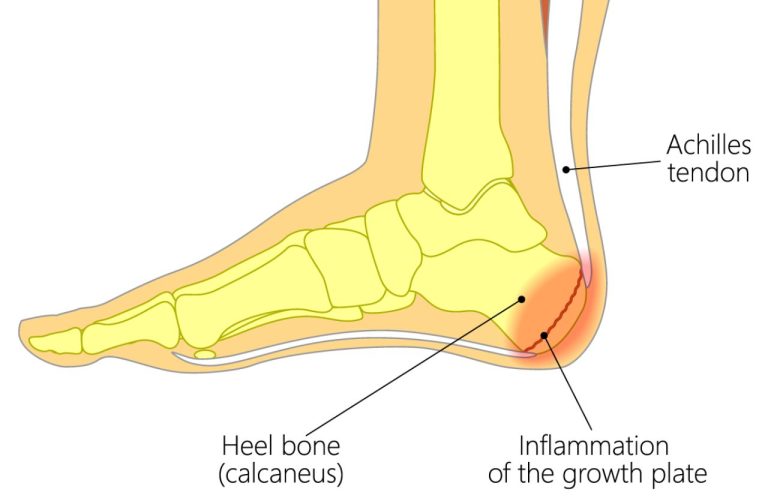Sever’s Disease (Calcaneal Apophysitis) is one of the most common causes of heel pain in children treated at Advance Foot Clinic. It typically affects children aged 8-14 years, largely due to the rapid growth changes experienced during this stage. Both boys and girls are equally impacted, with active children being most prone to developing Sever’s Disease.
Sever’s Disease is most commonly characterised by activity-related pain at the back of the heel, where the Achilles tendon attaches. It is an inflammation of the growth plate in the heel (calcaneus), often caused by repetitive stress, especially during growth spurts when heel bones, tendons, and muscles rapidly develop. Swelling and tenderness may also occur in the affected area. Foot pain is common in children who play sports involving running, jumping, or high-impact activities, such as football, basketball, and gymnastics.
Children with Sever’s Disease typically experience pain in one or both heels, especially after physical activity. They may also develop a limp and avoid movements that strain and contribute to tight Achilles tendons, such as jumping, hopping, or walking up and down stairs. In some cases, children may walk on their toes, which can be mistaken for Sever’s Disease, though this usually doesn’t involve heel pain.
Explore our blog, Foot Pain in Children, and discover common complaints and their causes.

Sever’s Disease typically causes various symptoms that impact a child’s daily activities. The severity of these symptoms can vary, but they generally result in discomfort and limitations, especially during or after physical activity. Here are the most common signs to look out for:
If your child has any of these symptoms, it’s best to contact Advance Foot Clinic. Our kids’ sports podiatry experts will rule out other conditions, such as stress fractures, tendonitis, or injury, and provide an accurate diagnosis of Sever’s Disease.
Sever’s Disease most commonly affects children between the ages of 8 and 14 during rapid growth periods. Several factors can contribute to the development of this condition:
At Advance Foot Clinic, we provide a comprehensive approach to treating Sever’s Disease. Our treatment plan is tailored to your child’s specific needs, and typically includes:
We’re committed to providing your child with a treatment plan that addresses the symptoms and supports long-term foot health, allowing them to get back to doing what they do best — running, playing, and enjoying sports.
When flare-ups occur, there are several steps you can take to help manage your child’s symptoms:
If flare-ups persist despite following these tips, we recommend booking an appointment with one of our podiatrists to rule out any injuries that may require medical intervention.
With four locations across Brisbane's north-western suburbs and a dedicated podiatrist in Mount Isa, we are conveniently positioned to serve our community.
From diagnosing and treating conditions like Sever’s disease to offering preventive education, we provide a full spectrum of care to ensure long-term foot health.
We listen carefully to your concerns and tailor our services to create treatment plans focusing on your recovery and well-being.
Our podiatrists design custom treatment plans based on your condition and lifestyle, using a variety of therapies to help you live pain-free.
Our professional podiatrists deliver high-quality care, staying up-to-date with the latest treatments to address all foot and ankle concerns.
We use cutting-edge technology for precise diagnoses and effective treatments, ensuring better outcomes and faster relief from conditions like Sever’s disease.
You can take steps to alleviate pain and discomfort, and when symptoms are mild or temporary, medical intervention may not be necessary. However, it is important to be proactive and monitor your child’s symptoms closely. Sever’s Disease, treated with a personalised treatment plan, helps children recover faster, so we recommend consulting a podiatrist for the best care.
Sever’s Disease is diagnosed through a physical examination and a review of your child’s medical history. A podiatrist will assess the heel for tenderness, swelling, and pain, particularly around the Achilles tendon attachment. X-rays or other imaging tests may rule out other conditions or confirm the diagnosis if needed.
Sever’s Disease is often difficult to prevent due to its connection with growth spurts. However, wearing sports shoes with good arch support, using supportive shoe inserts, and limiting high-impact activities can reduce the risk. Regular stretching and a strengthening program for the lower legs can also help prevent strain and promote overall foot health.
If your child’s symptoms persist or worsen despite following recommended care at home, it’s best to consult a podiatrist. They can provide a thorough assessment and offer treatment options. You may also want to check in with your child’s doctor for additional guidance for further relief if your child is experiencing severe pain.
Ready to give your feet the care they deserve? Book your appointment online or call us and experience our expert podiatry services at any of our clinic locations.